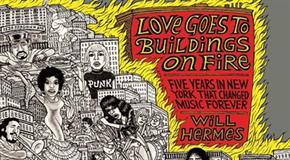Features
The Ramones To Philip Glass, NYC ‘70s Music Scene
Bob Marley opened a club date for Bruce Springsteen, Bronx DJs stole power from streetlights to fiddle with turntables in new ways, Philip Glass drove classical purists nuts with his sweeping, hypnotic compositions, and The Fania All Stars remade salsa. Down at CBGB’s, the Talking Heads were double-billed with the Ramones.
New York City has been pumping out great music from Gershwin to Gaga, but veteran music writer Will Hermes shows in his episodic and idiosyncratic book, “Love Goes to Buildings on Fire,” how 1973 through 1977 stood out as a time for innovation. Not only did the grimy time plant the seeds of hip-hop, it also fostered the highly influential scenes in jazz, Latino music, punk, disco, new wave and classical.

The book’s fiery title calls to mind Jonathan Mahler’s great snapshot of the city circa 1977 in “The Bronx Is Burning.” But where Mahler writes about the Yankees and other dramas in the city that year, Hermes focuses on a diverse cast of musicians over the five years, jumping from uptown to downtown in the troubled city.
“It was like life during wartime,” Hermes writes “But as in wars, life went on: love was kindled; music was made.”
It seems like everyone who strummed a guitar or manned a turntable makes an appearance in this book: Lou Reed, Patti Smith and Willie Colon are just a few. Readers are introduced to a gawky kid from Queens named Jeff Hyman who goes by Jeff Starship, but later changes his name to Joey Ramone. And there’s teenager Joseph Saddler, who started moving the records back and forth on his turntables to make cool noises. An early show went so badly he went home and cried. But the man who would become Grandmaster Flash caught on soon enough.
The book’s panoramic view is a strength and a weakness. The perfect reader for this book would be a music omnivore with Tom Verlaine, Lester Bowie, Chic and Ruben Blades on his iPod. If your musical tastes are narrower, interest in the braided stories might ebb and flow.
Also, the birth of hip-hop, Springsteen’s rise and the CBGB scene are oft-told tales. Hermes did a lot of fresh interviews but he also relies on memoirs and other published sources. There are no big revelations here.
The charm here is Hermes’ synthesis – the ever-changing points of view from around the city. Hermes also mixes in recollections from back then, when he was a Queens teenager. His memories of looking at the Manhattan skyline that seemed a million miles away across the river underscore that this is the author’s love letter to a time and place.